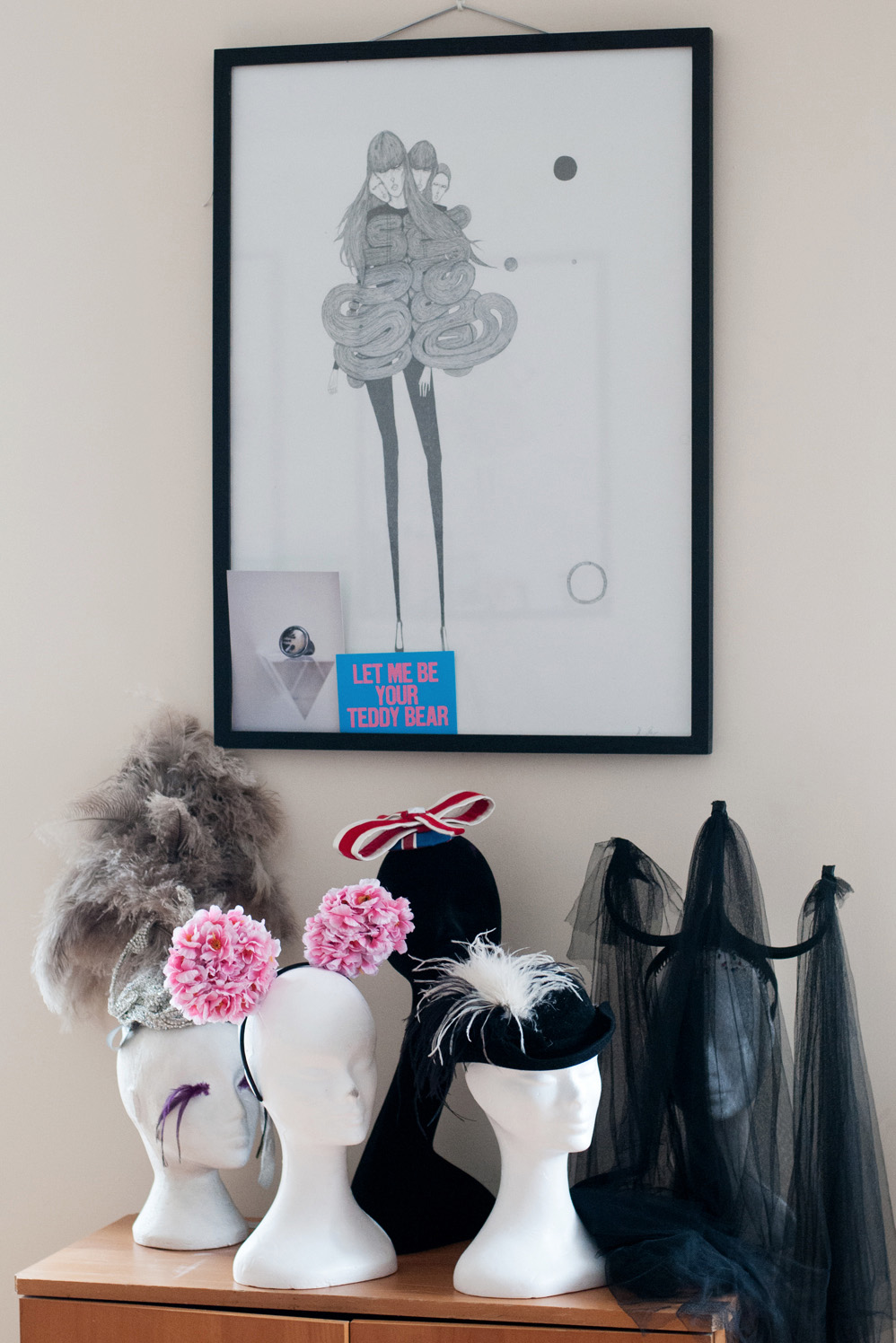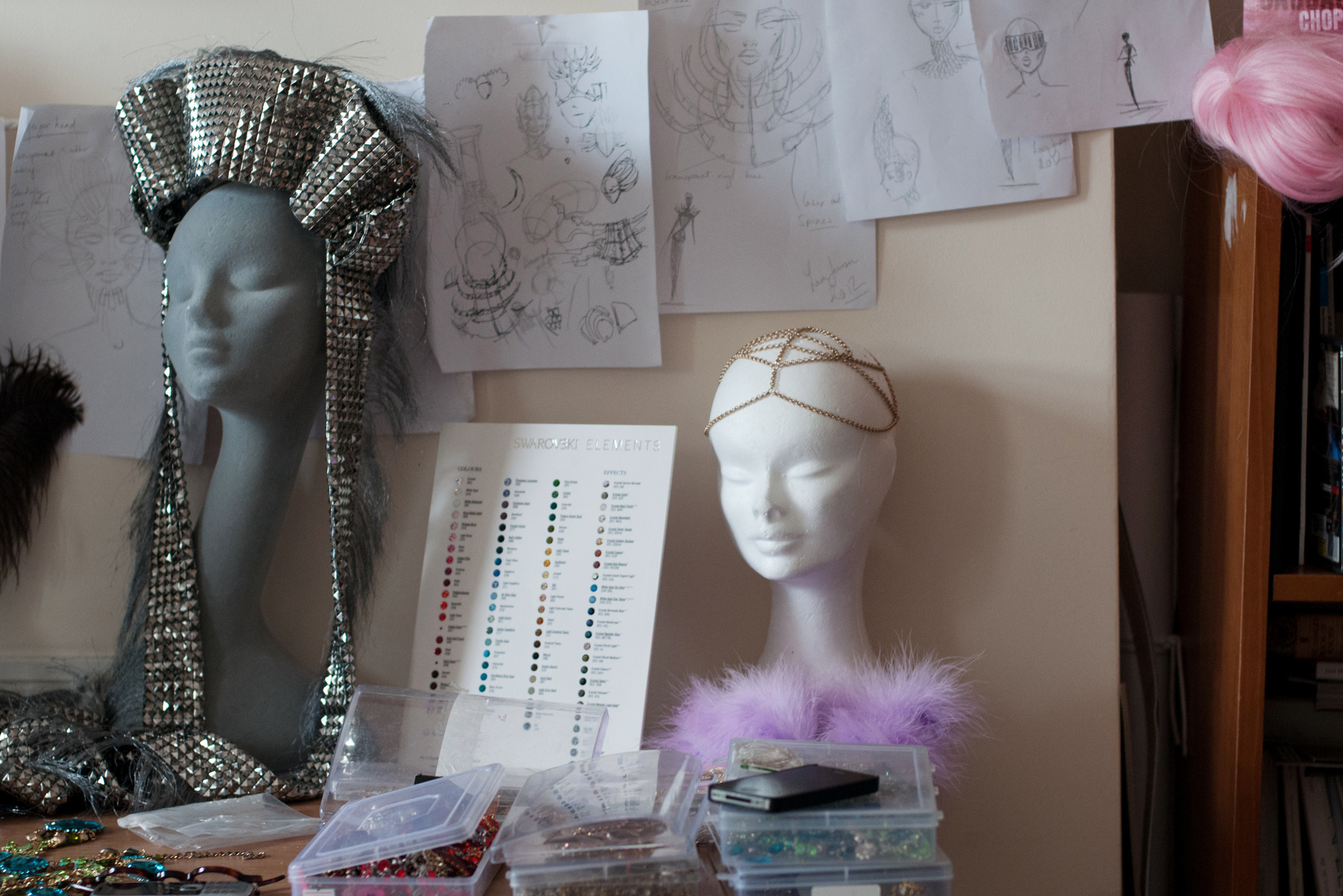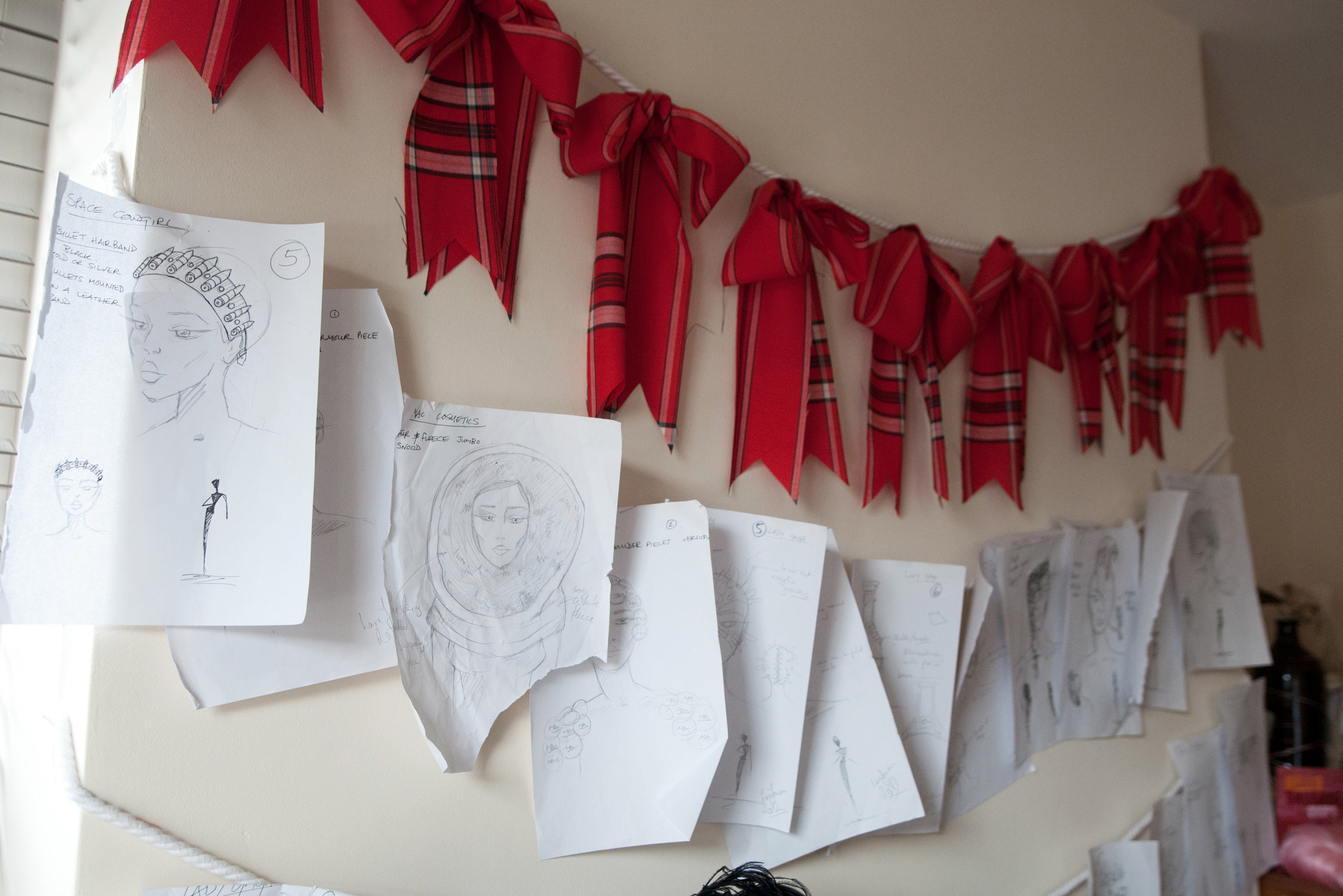Ever since she was little she has made at least one thing a day – and that is exactly what it feels like when Lara Jensen lets you explore her unique world of hat-making. She designs wondrous headpieces and has been working with remarkable photographers, artists and designers since graduation in 2009. For this year’s London Fashion Week she has worked in collaboration with Israeli designer Inbar Spector, designing and creating the spectacular jewelled face masks that brought her worldwide attention.
We met Lara at her studio in East London where she creates her extravagant one-of-a-kind headgear. Lara’s work is anything but traditional millinery – the pieces are a handcrafted mix of textures, materials and techniques. From her studio we went down Mare Street in East London where she invited us into her house – a place filled to the brim with her incredible collections of fabrics, hats, costumes, garments, drawings and illustrations.

























Where did you grow up and what did you want to be when you were little?
I am originally from Hull in East Yorkshire and grew up wanting to be a fine artist or a scientist – it was one extreme or the other. When I was younger I used to enter competitions to attend astronaut college or the chemistry club but I always had a knack for making things – that’s the engineering kind of mind I got from my father who used to be a physicist and is now an Art & Design technology teacher. I love looking at an object in all different kind of angles and being able to work out how its been made.
How did you end up in London?
I did a degree in Fine Arts at the University of Leeds and alongside that a lot of extracurricular theatre and costume design on student films and short projects. When I left university the first time I would go down to London and work as an Art Department assistant or with prop makers on films for three months. After a while I realised that I couldn’t sustain that lifestyle because it wasn’t paid work so I had to go back home. I nearly gave in and thought I’d never really be able to do something creative. One day a friend from London who studied at London College of Fashion wanted to meet me for lunch. I went with a couple of sketch books and a tutor saw my work and asked me to come in for an informal chat. A week later they offered me a place and a scholarship sponsored by Harold Tillman and I moved to London permanently.
How was it having a Fine Arts background doing a Masters in Costume Design for Performance?
It felt like I was thrown in the deep end of a university I never had access into before, because I hadn’t done much costume design in the past. I focused on the garment and the body in a creative and conceptual way as well as what atmosphere it can create in a room. I always found it very interesting how clothes and accessories can change the way we look at the person who wears it.
How did you get from costume design into hat making?
I always loved hats. Especially with millinery, you can create the most dramatic accessories on the body to be worn. I really liked the idea and wanted to learn at least the basic skills. Towards the end of my MA, I met the creative and inspirational Charlie Le Mindu. I worked with him for two and a half seasons as his studio manager and first assistant. While making these wondrous large pieces, I knew that I had creatively found something that I loved.
Can you to tell us a little bit more about your work?
There are certain aspects, which are very conventional. Some headpieces have all the elements you would consider to be traditional millinery – a buckram base which is steamed, moulded, shaped and embroidered, etc. I have a Fine Art approach to making head work in a way that I have a love for materials and textures. Rather than trying to stick within the lines of what is seen to be the skills of a traditional milliner, I work from a point where the concept or the object dictates the form that it ends up as. I have the skills and know the techniques but at the moment it’s more interesting for me to find out what I can come up with. I am aware of new trimmings and when they come into the stores and continuously look at different processes as well as new ways of making things.
It’s a luxury to draw something that you don’t know exists or is possible. Sometimes I’m working on a day’s turnaround and have to do all of the buying and making in that day. I have to have a very good knowledge of materials and where to get them – so I always keep my eyes open and try to feed many different elements into my work. Most of my pieces come from individual inspiration. I have a very collective mix of hats, designs and materials and chew through many ideas very quickly, every day. It takes a lot of self-restraint to stick to only one idea and develop it. I am addicted to making one-off pieces, which need to be considered and realised to a height level, quickly and from many different references.
When do you know a piece is finished and perfect?
It varies. It is all about composition and balance in a Fine Art sort of way. I have an instinct that tells me when to stop and leave it. I work from my drawings and do all the experimentation on the page. I know when a piece is finished when I’m happy with what it looks like as a drawing.
This year’s London Fashion Week and the collaboration with Inbar Spector brought you worldwide attention. Would you mark that as a turning point in your career?
I’ve been very lucky and as far as coverage in the press goes, I would say yes to a certain extent, although my client list had already started to expand before this. I’d also say my scholarship.
Can you tell us a little bit more about your collaborations and the people who commission your work?
I love collaborating. One very important piece was the collaboration with Gemma Slack, who I adore, for the Pirelli Calendar 2011 shot by Karl Lagerfeld. Designing the headpiece, making it, having it used and photographed but also to have someone like him compliment me on my work, who is so respected within the industry was very encouraging and a small triumph. Also I do part of the commissions for Lady Gaga. It’s great having such an extraordinary and creative person to make for, who is very open to what I have in mind. I am also starting to work with a taxidermist.
Do you consider yourself a designer or an artist?
I think the two overlap. Most of my inspiration comes from Fine Arts and although I would like to work as a fine artist within the fashion world, I think I am more of a designer.
How important is London for you as a place to live, work and get inspired?
It is very important and it totally isn’t at the same time. I still pull from a pool of inspiration I had when I was 12 or 15 years old – the things I loved then I still love now and as far as being a creative individual, I would have attempted to have done what I do wherever I was. London is a condensed hub of creativity where I have met and worked with incredibly talented people. Also I have access to a great variety of materials from fabric and model shops as well as millinery supply shops, which weren’t accessible to me in my hometown. I feel there is a buzz about London that gives you the stamp of acceptance that sometimes can be a stigmatism for designers that work outside of London.
Do you think London welcomes people who think outside of the box?
Yes. I think London welcomes anything that is slightly off the path. There is an acceptance for being creative and using your imagination that I’m not sure you can get in any other city. London has a very competitive but supportive community of creatives that are trying to make it.
What will the future bring for you?
For me, it’s little steps at a time. I am trying to have a full collection out by next season with my own show or presentation and a fashion film. I want to be able to have artistic license over my work and to be fortunate enough to collaborate with other very creative and inspiring people. 2011 and 2012 have been very good years for me – touch wood.
Thank you Lara for this nice interview!
Interview: Carla Kämpfer
Photography: Owen Richards
